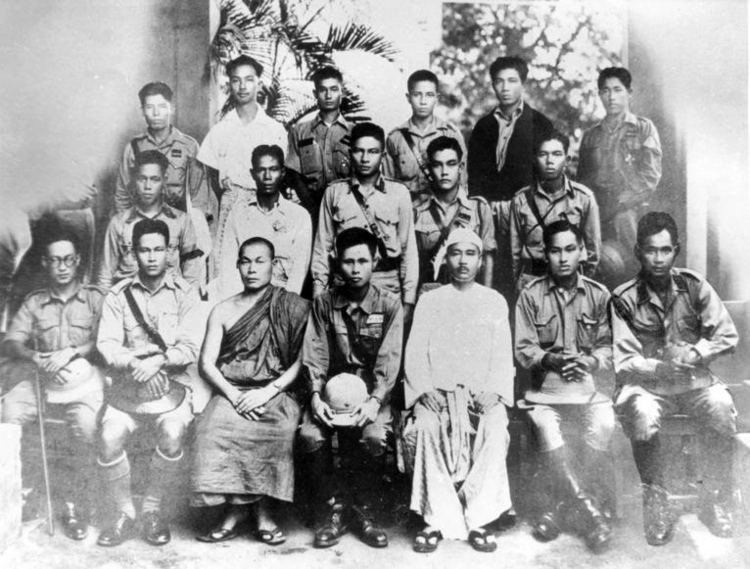 | ||
The Thirty Comrades (Burmese: ရဲဘော်သုံးကျိပ်) constituted the embryo of the modern Burmese army called the Burma Independence Army (BIA) which was formed to fight for independence from Britain. This was accomplished just before the majority of the Thirty Comrades returned with the invading Japanese Army initially through Southern Burma in December 1941.
In April 1941, small groups of Burmese youth left Burma secretly to obtain military training to fight the British in the struggle for independence. Their leader was Thakin Aung San and they were sent by the Dobama Asiayone ("We Burmans Association") with the intention to get assistance from the Chinese Communists. By a quirk of fate, however, they ran into the Japanese instead in Amoy and arrived in Japan later to be flown to Hainan Island, China (which was then occupied by Japan), in order to receive military training by the Japanese Army. They were later moved to Formosa for security reasons and subsequently returned to Burma via Vietnam and Thailand with the Japanese army. On 26 December 1941, in a house (owned by a Burmese Doctor) in Bangkok, about 25 of the Thirty Comrades had their blood drawn from their arms in syringes, then poured into a silver bowl from which each of them drank – thway thauk in time-honoured Burmese military tradition – pledging "eternal loyalty" among themselves and to the cause of Burmese independence. Their average age was just 24 years. A Japanese officer called Suzuki Keiji, better known among the Burmese by his nom de guerre Bo Mogyo (Commander Thunderbolt) and head of a special intelligence unit called Minami Kikan (南機関) formed in order to support a national uprising in Burma, was the mentor and principal trainer of the Thirty Comrades. The British were driven out of Burma to India during World War II.
The Thirty Comrades, each taking a nom de guerre, were:
According to a historian of Burma Professor Gordon H Luce, who in the pre-war years taught at Rangoon University, the Thirty Comrades led by General Aung San helped establish the 4th Burmese State in history (the 1st by King Anawrahta (1044–1078), the 2nd by King Tabinshwehti (1530–1550), the 3rd by King Alaungpaya (1752–1760)).
Dr Ba Maw who was the Head of State and "Supreme Leader' (in Burmese Adipadi Gyi) from August 1943 to about March 1945, during the administration established by the Japanese, had somewhat different opinions on the role of the Thirty Comrades. (See Ba Maw, Breakthrough in Burma: Memoirs of a Revolution 1939–1946, Yale University Press, 1968).
Bo Ye Htut (no. 15), the last of the Thirty Comrades, died at the age of 92 on 28 November 2013, after Bo Kyaw Zaw (No. 14) died in Kunming on 10 October 2012, Among the prominent leaders of the Thirty Comrades who had died over the last decade were Bo Ne Win (No. 6) who died on 5 December 2002, and who from March 1962 to about ten years beyond his "retirement" in late July 1988 was the ruler, and in later years the "puppet master", of Burma, and Bo Hmu Aung (No. 9) who died in 2004.
